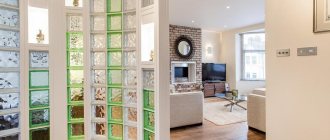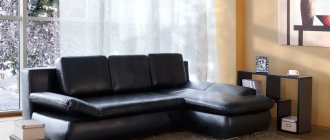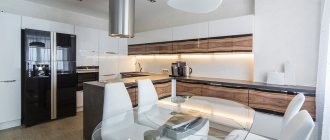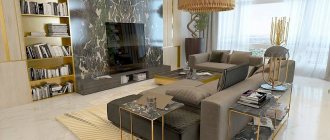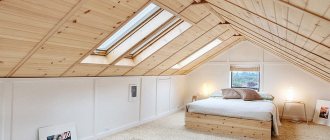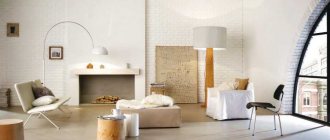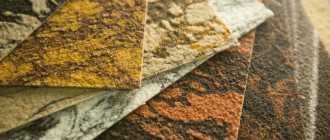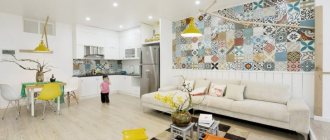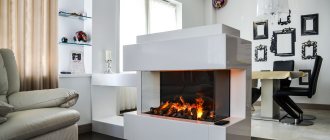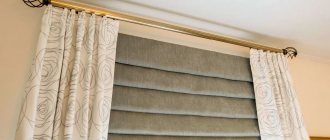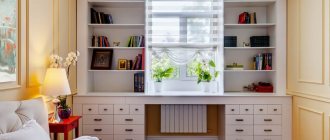Why not look at the world through rose-colored glasses? More precisely, through the multicolor prism of stained glass windows. Stained glass windows in the interior transform the space, make it festive, sophisticated and are perceived as an element of luxury. Stained glass windows, lamps, partitions are sources of incomprehensible magic. Colored reflections scatter across the walls, play on glass surfaces, giving the interior sublimity and uniqueness.
Stained glass kitchen window
History of stained glass
The first stained glass windows were created from small pieces of glass held together by strips of metal, the remains of which were found in Egypt and are over 5,000 years old. The reason for such an intricate technology is explained by the fact that humanity has not yet been able to produce glass of the required area.
In Italy, instead of glass, plates of translucent minerals were inserted into the windows: selenite, alabaster - this protected the rooms from the hot sun and created a mysterious penumbra. Soon they learned to paint glass blue and red, and much later - yellow. Stained glass became an integral part of the architecture of Gothic cathedrals and was subsequently associated for a long time with majestic narrative paintings made of colored glass. The bright rays of the sun broke into myriads of colored fragments, filling the sparse interior of the cathedrals with an unearthly light.
Stained glass door to the spirit
Since then, bursts of fashion for stained glass in the interior have been replaced by oblivion, and new areas of application have been found for them. Stained glass began to decorate not only windows, but also furniture, doors, lamps, remaining an expensive decor for palaces and church cathedrals.
Nowadays there is a surge in interest in stained glass, and it is associated with at least two reasons:
- with a high degree of unification in the construction of buildings and interior decoration;
- with advances in stained glass technology.
Let's consider what traditional and new technologies are used by modern stained glass manufacturers, and what application they find in decorating modern interiors.
Stained glass front door
About techniques for creating stained glass images
Stained glass is a type of fine art that uses colored glass to create paintings and images. In the old days, glass was available only to wealthy people, and paintings made of colored glass generally cost incredible amounts of money. Today, not too complicated and expensive techniques have been developed that make this pleasure quite accessible. There are several different techniques for creating such products:
- Stacked and mosaic stained glass windows. Made from pieces of glass. They differ in that in mosaic, the fragments have the same shape and size; in typesetting, they are cut to the required sizes and can have different shapes. The fragments are fixed in metal frames (lead, copper, brass). One of the varieties is soldering - the picture is obtained using tin partitions. This is one of the most ancient techniques. More modern - Tiffany stained glass. In them, the fragments are collected on a copper tape, due to which they have less mass.
Traditional technique - stacked stained glass
- By fusing pieces of colored glass into a single whole (fusing or sintering technique). This is exactly a new and relatively inexpensive technology.
Fusing stained glass can be distinguished by the absence of lintels
- Etching technique. Using hydrofluoric acid, the color is etched out in those places that should be more transparent. This technique produces two-color images. A more complex technology of layer-by-layer etching allows you to make not only multi-colored, but also three-dimensional stained glass windows.
Deep layer-by-layer etching technique - glass frosting
- Painted stained glass window. Images are created using special transparent paints, which are fixed at high temperatures (finish firing).
Painted stained glass - a design is applied using paints and fixed at high temperature
The techniques for making stained glass are different, but they all require special skills and knowledge. Some also require high-temperature ovens.
Imitation methods
The complex technology of creating stained glass windows is reflected in their cost - this is not a cheap pleasure at all. Therefore, in parallel with stained glass technologies, imitation methods have been developing since ancient times. The very first ones - sticking a thin sheet of painted paper onto the glass - turned out to be very short-lived. But modern technologies make it possible to obtain more similar and durable pseudo-stained glass windows:
- Filled polymer contour. It is created using transparent colored polymers in two stages. At the first, contours are drawn on the glass. After polymerization, the space between the contours is filled with colored compounds.
Pouring technique - using polymers to create a pattern on glass
- Film stained glass. To create contours, self-adhesive lead tape is used, with which the contours of the design are drawn. Then the space is sealed with colored stained glass film.
Film stained glass is the easiest to make yourself. but not too durable
- Overlay stained glass. Simulates prefabricated stained glass: colored glass is glued onto a base of transparent glass. This technology is much simpler, since the strength is provided by the “substrate”.
Methods for simulating stained glass are technically simpler, which makes it possible for non-professionals to make some not too complex designs. At the same time, the products look good, which determines their popularity.
Types of stained glass – from exclusive to democratic
Let's consider three groups of stained glass windows:
- typesetting;
- seamless;
- embossed;
- film
typesetting
In the manufacture of type-setting stained glass windows, two technologies are used:
- Classical
- Tiffany.
Classic typesetting stained glass windows are made of colored glass, cut exactly according to the sketch, connected to each other by an H-shaped lead profile. In modern production, instead of harmful lead, brass, copper, aluminum and cupronickel are used.
Classic typesetting stained glass windows are characterized by rather thick, bright contour lines that correspond to our ideas about stained glass windows from ancient palace or church interiors. Such stained glass windows are traditionally used in windows, but in modern interiors they are used to decorate partitions, lanterns, and wall panels with internal lighting.
Modern stained glass window in minimalist style
The technology of making Tiffany stained glass, invented in the 19th century in America, also belongs to typesetting. In it, the glass is also cut out according to the sketch, but connected to each other differently. Each of the fragments is wrapped around the perimeter with copper foil tape, then the contours are soldered together, and a single stained glass canvas is formed. The creator of the technology, Louis Tiffany, also invented a new way of painting glass in the finest shades. In addition, this technique involves the use of special types of glass, textured surfaces, and the presence of convex and concave elements, which expands expressive possibilities.
The elegant golden outline and new glass coloring technologies allow you to create real works of art. Tiffany stained glass windows illuminated by the sun are an exclusive decor for luxurious interiors. Tiffany technique is used to decorate windows, ceilings, and lamps.
Stained glass above the interior door
Seamless
Seamless technologies include:
- fusing;
- casting;
- etching and sandblasting technology
A completely new technique for creating stained glass - fusing - was invented quite recently, in Germany, in the 90s of the 20th century. Stained glass fragments are not held together by a contour frame, but are sintered at high temperature. Colored parts are laid out on a flat sheet of glass and kept at a temperature until the colored glass softens and fuses with the substrate and adjacent elements.
Stained glass fusing is a fashionable element of the interior; they are distinguished by unique features: the absence of boundaries, smooth color transitions. They are readily used in damp rooms, bathrooms, where stained glass panels are subject to oxidation, and are incredibly effective in window decoration. But fusing technology is especially often used to decorate interior elements - lamps, ceiling lamps, furniture.
Large composition of several windows
Casting is a technology very similar to fusing, but metal contours are used in the production process. They are laid out on a glass substrate, colored glass is placed in the cells, which, after softening, fills the mold and is firmly sintered with it and the substrate. The pattern on stained glass using the casting technique has a contour emphasized by metal, which is also appreciated by interior designers. In addition, the technology makes it possible to make some elements convex.
A special type of stained glass is stained glass made of transparent glass, enhanced by etching. Areas of glass are treated with hydrofluoric acid to create a matte finish. Not everyone knows that in interior design you can use an interesting feature of stained glass using the etching technique - when illuminated from the end, the matte areas glow from the inside.
A safer technology for applying a matte pattern is sandblasting, although in terms of expressiveness and elegance of the design it cannot be compared with etching.
Such stained glass windows are widely used for doors, partitions, windows and any elements of interior decor, including in wet rooms.
Classic stained glass in the bathroom
Embossed
This group includes, first of all, faceted stained glass windows. They are made of thick transparent glass, less often colored glass, using a special cut.
Bevelling is essentially glass carving, chamfering. This is a complex technique that requires a lot of experience from the master. When a bevel is removed along the perimeter of a glass fragment, the sun's rays are refracted in the edges and scattered in a fireworks display of bright highlights. The faceted cells are united by a thin metal frame.
Stained glass windows using the bevel technique are unique due to their special internal glow, the play of light on the edges; in the interior they especially magically transform windows. Faceted stained glass windows are also used to decorate doors, mirrors, and accessories.
Classic stained glass in the kitchen
Film
A very democratic way to create stained glass is film technology. It arose in the 70s of the 20th century. A thin transparent film with a colored pattern is applied to the glass. The self-adhesive lead circuit is secured in the same way.
Film technology has transformed stained glass from an element of luxury into affordable interior decor. Film stained glass gives the glass additional strength - even if it breaks, the film prevents the fragments from scattering. Modern manufacturers recommend this effective, inexpensive technology for self-decorating furniture doors, windows, interior doors, and small decorative details.
Stained glass in retro style
Modern stained glass techniques
The modern understanding of stained glass has expanded: now it includes not only works of colored glass made using complex classical technology, but also various imitations. However, just as furniture made of natural wood differs from laminate, real stained glass differs from imitation.
Decra LED technology
This is a high quality alternative to natural stained glass. The quality and appearance of modern stained glass is not inferior to, and in some cases superior to, natural stained glass. This is achieved through:
- neat lead broaches;
- volume and shine of the crystal elements used;
- the ability to produce radius stained glass (curved glass);
- use in any climatic conditions.
English certified materials are used in the production of stained glass:
- The basis for stained glass can be transparent, tinted, or chemically frosted opaque glass with a thickness of 4 mm or more. At the request of the customer, for safety reasons, we use tempered glass;
- more than 280 types of beveled glass lens elements (beveli);
- special color films of 70 types of different textures and a UV filter against fading;
- lead broaches with a width of 3 to 22 mm in 7 colors (natural, gold, brass, graphite, black metallic, white, platinum).
CRI technology (lacquer stained glass)
As in the previous technology, when making stained glass, solid glass is used as a base. A volumetric contour (stained glass graphic) is applied to this glass by machine using liquid polymer materials. After a day, when the contour dries, manual filling is done with colored varnishes.
The warranty on our products is 10 years
Stained glass windows in a modern interior
Stained glass windows can decorate interiors of both classical and modern styles. Exquisite faceted stained glass windows and breathtakingly expensive Tiffany windows, as well as elements made using the etching technique, look organically in classic and baroque styles.
Interiors with antique English or Spanish furniture are nobly complemented by classic stained glass windows. Artistic, airy Art Deco will be enriched with the ringing texture of casting or beveled stained glass windows. Delicate color transitions of fusing glass mosaic and subtle contours of stained glass casting will add a touch of sentimentality to Empire style interiors.
Small stained glass window in the bathroom
An interior in a bohemian boho style or in an ornate oriental style will “accept” stacked stained glass windows using classical techniques and with a modern brass or copper frame profile. A loft, unthinkable without bright elements of luxury, can be effectively decorated with either antique stained glass using classical techniques or film stained glass in the spirit of Andy Warhol’s paintings.
Democratic versions of stained glass using sandblasting or film techniques are common in interiors that follow Scandinavian or Japanese minimalism.
Stained glass on the ceiling with lighting
Art Deco stained glass windows
A decorative style for a luxurious interior, combining outright chic with rigor, intelligence and perfect taste. This combination alone can amaze the imagination with a paradox, and the plus is the festive lightness, air and light, sparkle and freedom in the interior. There are many fans of the Art Deco style, despite the difficulties in the source data. To be able to use this style, you need high ceilings, a considerable area, a panorama of high windows, and so on.
Art Deco stained glass is as austere and luxurious as the overall style it reflects. Large details and symmetry, almost sacred - evoking associations with the Egyptian pyramids. The style is young and very fashionable, and surprisingly varied. recognizable signs of the style are clarity of lines, strict graphics and symmetry, transparency of pure colors and repeating patterns.
Techniques for Art Deco can be any, but the closest approximation is provided by stained glass windows, whose design is made up of individual fragments of cut glass, colored or etched. Simplified painting techniques, film and poured, can help express the idea of Art Deco, provided that the colors and shapes are chosen correctly.
Accessories that define your mood
Stained glass windows are associated primarily with the high windows of Gothic cathedrals, but what place do they occupy in a modern interior?
Manufacturers have put a lot of effort into developing new stained glass techniques, so varied that it is difficult to name rooms in whose interior stained glass elements could not be used.
Let's look at the most common areas of their application.
The most advantageous technique is stained glass when decorating windows. They look especially impressive in windows facing south. It is precisely when illuminated by the sun and casting mysterious colored reflections that they become a key decorative element of the interior, creating a unique sublime atmosphere.
Photo: stained glass in the bathroom
However, in modern interiors, designers are not limited to established traditions and are finding new areas of application for stained glass. They offer lampshades and ceilings illuminated from within, entirely made using the classic stained glass technique, and partitions using various techniques - sandblasting, classical, fusing.
For partitions and other decorative elements in the bathroom, the fusing technique is ideal, which does not have metal parts and is very durable. Film stained glass windows can be considered a democratic alternative for placement in damp rooms.
Decorative stained glass in the bathroom
In modern interiors, stained glass is often used in an unconventional way - to decorate lamps, mirrors, or act as paintings illuminated from within. Stained glass windows are used to decorate furniture doors – here the leaders are strict ornaments using sandblasting techniques or luxurious exclusive designs applied by etching.
It is advisable that the stained glass motif be repeated three times: in the dominant element, for example, a window or partition, and in one or two smaller ones - a lamp, a painting or a mirror frame.
Stained glass in kitchen cabinets
Magical atmosphere of happiness
Stained glass windows have the ability to transform any room beyond recognition.
Stained glass windows bring a sense of celebration to the living room, emphasizing at the same time its solidity and originality, and in the bedroom they will create a mysterious, intimate atmosphere.
Splashes of colored highlights will fill the children's room with the magic of a good fairy tale. In the bathroom, the light passing through the stained glass partitions and reflecting off the water makes you remember the wonderful weeks spent on the ocean coast.
What about the hallway? It is worth placing curved lamps here, or an illuminated stained glass panel, and, having crossed the threshold of the house, you can safely discard everything routine and everyday and rejoice in meeting loved ones.
Stained glass in the interior
Additional information about stained glass
This type of room decoration has advantages and disadvantages, just like any item. And you should know the strengths and weaknesses of stained glass windows in order to make an informed choice.
Positive properties/qualities of stained glass:
stained glass can be located in any interior style - this decorative element looks great in high-tech style, modern style, and even baroque style;- it refracts light perfectly, making its rays truly enveloping, giving coziness and comfort;
- the decor in question can be placed in a room of any size, even the smallest - there will be a place for a niche, lamp or tabletop in any case;
- Stained glass in itself is an elaborate decor, so there is no need to get fancy with any additional elements or objects.
The designers do not mention the disadvantages of stained glass - it is believed that such decor will not bring disharmony to the room if the color scheme is well chosen. But you should take into account that everything that is unique is expensive, sometimes the cost of such products can reach simply astronomical amounts. This also applies to stained glass windows - they are original, unique and very expensive.
Many people wonder how expedient and practical it is to use stained glass in the design of residential premises? The answer will be given by designers and those who are already actively using the type of decor in question :
- It is unreasonable to use stained glass as a floor covering - this statement applies only to those rooms in which there are large crowds of people (for a bathroom such a floor is quite appropriate);
- lamps, tabletops and mirrors with stained glass fully perform their usual functions - the decor in this case is made of special tempered glass;
- ceilings and niches with stained glass will add sophistication to the room, but they should only be used individually - too many stained glass windows will overload the perception of the interior.
Stained glass in the interior is always original and stylish. No matter how sophisticated, luxurious and presentable your house or apartment is, the type of decor in question will make it cozy and comfortable, with a touch of exclusivity.
( 86 votes, average: 4.80 out of 5)
Shower cabins - types, characteristics, assembly rules
DIY screen: history and types, homemade from wood, polystyrene foam, scrap materials
